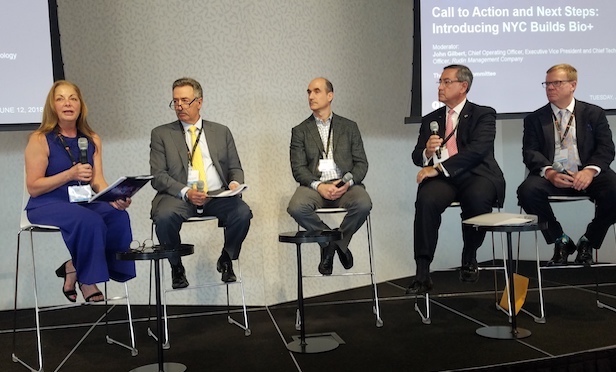
NEW YORK CITY— Cities across the country are looking toward life sciences technology as the next boost for their economies. New York City has diversified its economy, shifting from the sheer dominance of financial services, expanding to areas including media, information, technology and biotech.
But the life sciences industry in New York is constrained by the lack of available, affordable laboratory space, according to organizers of the Life Sciences 2018 Real Estate Development Symposium held at the New York Academy of Sciences last Tuesday.
The conference focused on connecting those seeking science research space to developers who can create it.
A panel of the symposium's steering committee addressed the steps New York City needs to take to become the next biotech capital of the world.
Find the Space to Develop
Limited space in New York—It's always an issue. The panel moderator, John Gilbert, COO, executive VP, and chief technology officer at Rudin Management Company, suggested working with the Real Estate Board of New York to create a database of buildings that could be used as life sciences buildings. As an analogy, he called the downtown neighborhood surrounding the conference's location at 250 Greenwich St., “Telecom Heaven.” With an industry cluster of telco businesses, Gilbert said there were “more terabytes of data running through this neighborhood than any, other than in Hawaii.”
He opined industry professionals must define buildings that have the bones for life science, identify the neighborhoods and match and bring the real estate and life sciences communities together.
Get Government Backing
“One of the biggest hurdles is the financial hurdle, the initial investment,” said John Sabey, CEO of Sabey Corporation, a developer and operator of data centers. He stressed the importance of maintaining visibility for city and state governmental support.
Induce businesses to choose New York City with measures like tax incentives because setting up a life science lab or facility is more challenging in urban environments, said Sabey.
Mitchel W. Simpler, managing partner at Jaros, Baum & Bolles, a mechanical and electrical consulting engineering firm, underscored the city's commitment. “We've got a partner in EDC [New York City Economic Development Corporation] that has half a billion dollars on the table right now for a developer and an economic partner,” said Simpler. “EDC has stepped up to the plate. New York is clear to everyone in the city and outside that they are here to play a serious game.”
EDC's LifeSci NY is a $500 million investment launching 10 initiatives and private-public partnerships to support healthcare and technology businesses. In addition, New York's Empire State Development is offering $47 million through the Innovate NY Fund to support the biotech and life sciences industry.
Get Private Investments
James C. McKenna, president and CEO of Hunter Roberts Construction Group, pointed out pharmaceutical giants have shrunk in New Jersey. He supports trying to partner with them to open incubator spaces in New York City. These companies already have experience with industry facilities and real estate.
Jonathan Mechanic, chairman of law firm Fried Frank's real estate department, said developers need to better understand life science building investments compared to Class A office buildings to justify them. Both developers and lenders need to see returns in life sciences real estate as a good investment.
Simpler noted scalable investments could accommodate different types of offices. That way developers could plan for the future should the life sciences occupancy come to fruition.
“You have the building and the plan to invest,” added Mitchel, noting that the investments do not all have to be upfront.
A Life Sciences City Needs Branding
To get public support, dollars and private investments, life sciences real estate needs stronger branding. Nancy J. Kelley, president and CEO of Nancy J Kelley + Associates, healthcare, research and life sciences industry consultants, says that life sciences must raise market awareness, especially in the developers' market.
To get tax breaks, public support and private investments, cities need to build a brand combining real estate with life sciences. It must be recognizable, exciting and inspirational, said Kelley.
An audience member offered that New York should brand itself as uniquely combining life sciences, design and industry with connections across the country and the world. He updated the often used phrase to “The city where people come to live, work and play and connect.”
© Touchpoint Markets, All Rights Reserved. Request academic re-use from www.copyright.com. All other uses, submit a request to [email protected]. For more inforrmation visit Asset & Logo Licensing.







